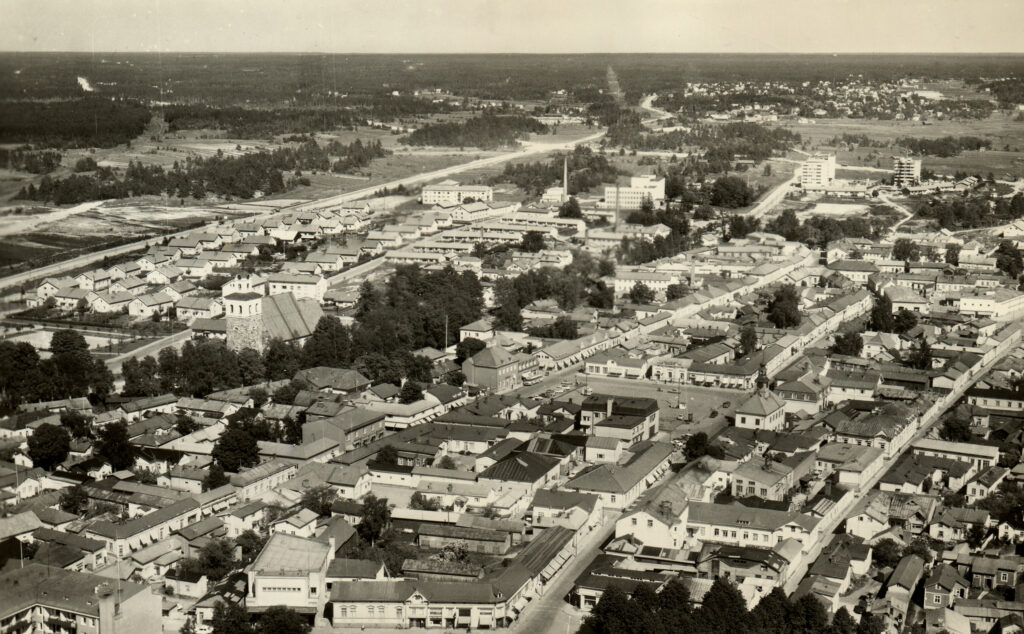Keijola
Vanhankirkonkatu 22
Property code: 001-140-83

History
In 1800, the plot belonged to the patron Johan Grundström. He had eight kapanala seedlings and two barns.
Fire insurance
Christian Sjöblom, a master leatherworker, took out a fire insurance policy in 1850. The main building was located at the corner of Vanhankirkonkatu and Isopoikkikatu. The south wing of the angular building was built in earlier times, and the west wing in 1847. The building is neither planked nor painted and has a pitched roof. On the courtyard side is a boarded porch with a simple double boarded door. There are eight windows. There are also eight rooms; an entrance hall, a hall, three chambers, a bread room, a chalk room and a barn. The rooms have a total of four tiled stoves and one baking stove with oven. Five of the partition doors are semi-transomed, with a few board doors. The tiled stoves are flat brown glazed, one columnar and two round.
On the eastern side of the plot is a carved iron building made of logs and partly of board. It was built in 1848 from new materials, and is unplanked and unpainted. It has a barred window. The rooms are a leather barn, a lean-to, a shed, a workshop and a pantry. The building has one cupboard stove with a copper masonry pot of 50 jugs. At the back of the courtyard is another small building, built in 1850. It too is unplanked, unpainted and with a pitched roof. It has three windows. The small building has three rooms: an entrance hall, a workshop and a cellar with double moss-clad log walls. Between them is moss as insulation. The building also has a stove. The gate to the plot is a double plank gate, painted with oil paint. Next to the gate is a smaller access gate.
In 1895, the house was reinsured. The house was then owned by the tanner F. W. Qvarnberg. The main building now had an asphalt shingle roof. The building had seven rooms, two halls, two chambers, a kitchen, a stable and a barn, with a boarded-up shed at the north end of the wing facing Isopoikkikatu. There was a boarded porch in the inner corner of the building. The entire building was raised in 1990 and 1991, covered with felt, boarded and oil-painted, and fitted with modern doors and windows. The kitchen wall and all the ovens are made of porcelain tile. The inside of the rooms have been raised, re-papered and painted.
Karvari’s studio is also partly boarded up, painted with oil paint and covered with felt. This building has also been raised, the interior combined into a single space, and the windows, doors, floors and chimney have been replaced.
Modification drafts
The alteration drawing of the buildings dates from 1890 and is by John Fredr. Lindegren. There is a residential building at the corner of Vanhankirkonkatu and Isopoikkatu, an outbuilding with an end facing Vanhankirkonkatu and a small building at the back of the yard. The alteration drawings include a neo-renaissance lining for all the buildings and a gateway in the style of the old building along Vanhankirkonkatu. The windows in the main building will be mullioned, while the windows in the other buildings will be six-paned. The window surrounds on the main building are also more ornate than elsewhere. The building on the corner of Vanhankirkonkatu has two sections with double doors, of which it is now intended to demolish the parts between the hallway and the rooms, as a new porch-like hallway was to be built on the corner. After the conversion, the living space will consist of three rooms on the Vanhankirkonkatu side and a room and kitchen on the Isopoikkikatu side. The Isopoikkikikatu wing will continue with a board shed and a log barn, to the side of which a new latrine was to be built. It is in a fenced-off part of the yard. The building on the eastern boundary of the site has a leather shop at the street end, which was accessed from the yard. It was followed by a drying shed for hides and a room called the Wärkkihuone, which had tannery ponds.
The courtyard building has a tannery, where a more efficient heating system was built in 1894 to dry the hides better. In 1903, a shop door was built on the side of the main building facing Isopoikkikatu.
In 1971, it was decided to replace the high gate with a simple, low board fence with a gate. The blockhouse was demolished in the 1980s. The corner building was renovated and its fittings improved. In 1984, the building with its end facing Vanhankirkonkatu was altered. The street-side dwelling was modernised. A car and carpenter’s workshop was added next to it. The long low part of the outbuilding was demolished. The construction of a high gate was again in order.
Current situation
Building at the corner of Vanhankirkonkatu and Isopoikkikatu
Long-cornered residential building, south wing probably built in the early 19th century, west wing in 1847, neo-renaissance roofing in 1890 (John F. Lindegren), hipped roof
Residential building on the side of Vanhankirkonkatu
Long-cornered residential building, built in 1848, neo-renaissance style in the 1890s
Gate
Redesigned in the spirit of the gate designed by Arvi Forsman in 1903, based on a design by John F. Lindgren.